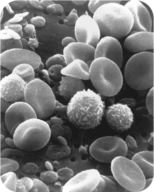11.26: Blood
- Page ID
- 14326
\( \newcommand{\vecs}[1]{\overset { \scriptstyle \rightharpoonup} {\mathbf{#1}} } \)
\( \newcommand{\vecd}[1]{\overset{-\!-\!\rightharpoonup}{\vphantom{a}\smash {#1}}} \)
\( \newcommand{\id}{\mathrm{id}}\) \( \newcommand{\Span}{\mathrm{span}}\)
( \newcommand{\kernel}{\mathrm{null}\,}\) \( \newcommand{\range}{\mathrm{range}\,}\)
\( \newcommand{\RealPart}{\mathrm{Re}}\) \( \newcommand{\ImaginaryPart}{\mathrm{Im}}\)
\( \newcommand{\Argument}{\mathrm{Arg}}\) \( \newcommand{\norm}[1]{\| #1 \|}\)
\( \newcommand{\inner}[2]{\langle #1, #2 \rangle}\)
\( \newcommand{\Span}{\mathrm{span}}\)
\( \newcommand{\id}{\mathrm{id}}\)
\( \newcommand{\Span}{\mathrm{span}}\)
\( \newcommand{\kernel}{\mathrm{null}\,}\)
\( \newcommand{\range}{\mathrm{range}\,}\)
\( \newcommand{\RealPart}{\mathrm{Re}}\)
\( \newcommand{\ImaginaryPart}{\mathrm{Im}}\)
\( \newcommand{\Argument}{\mathrm{Arg}}\)
\( \newcommand{\norm}[1]{\| #1 \|}\)
\( \newcommand{\inner}[2]{\langle #1, #2 \rangle}\)
\( \newcommand{\Span}{\mathrm{span}}\) \( \newcommand{\AA}{\unicode[.8,0]{x212B}}\)
\( \newcommand{\vectorA}[1]{\vec{#1}} % arrow\)
\( \newcommand{\vectorAt}[1]{\vec{\text{#1}}} % arrow\)
\( \newcommand{\vectorB}[1]{\overset { \scriptstyle \rightharpoonup} {\mathbf{#1}} } \)
\( \newcommand{\vectorC}[1]{\textbf{#1}} \)
\( \newcommand{\vectorD}[1]{\overrightarrow{#1}} \)
\( \newcommand{\vectorDt}[1]{\overrightarrow{\text{#1}}} \)
\( \newcommand{\vectE}[1]{\overset{-\!-\!\rightharpoonup}{\vphantom{a}\smash{\mathbf {#1}}}} \)
\( \newcommand{\vecs}[1]{\overset { \scriptstyle \rightharpoonup} {\mathbf{#1}} } \)
\( \newcommand{\vecd}[1]{\overset{-\!-\!\rightharpoonup}{\vphantom{a}\smash {#1}}} \)
\(\newcommand{\avec}{\mathbf a}\) \(\newcommand{\bvec}{\mathbf b}\) \(\newcommand{\cvec}{\mathbf c}\) \(\newcommand{\dvec}{\mathbf d}\) \(\newcommand{\dtil}{\widetilde{\mathbf d}}\) \(\newcommand{\evec}{\mathbf e}\) \(\newcommand{\fvec}{\mathbf f}\) \(\newcommand{\nvec}{\mathbf n}\) \(\newcommand{\pvec}{\mathbf p}\) \(\newcommand{\qvec}{\mathbf q}\) \(\newcommand{\svec}{\mathbf s}\) \(\newcommand{\tvec}{\mathbf t}\) \(\newcommand{\uvec}{\mathbf u}\) \(\newcommand{\vvec}{\mathbf v}\) \(\newcommand{\wvec}{\mathbf w}\) \(\newcommand{\xvec}{\mathbf x}\) \(\newcommand{\yvec}{\mathbf y}\) \(\newcommand{\zvec}{\mathbf z}\) \(\newcommand{\rvec}{\mathbf r}\) \(\newcommand{\mvec}{\mathbf m}\) \(\newcommand{\zerovec}{\mathbf 0}\) \(\newcommand{\onevec}{\mathbf 1}\) \(\newcommand{\real}{\mathbb R}\) \(\newcommand{\twovec}[2]{\left[\begin{array}{r}#1 \\ #2 \end{array}\right]}\) \(\newcommand{\ctwovec}[2]{\left[\begin{array}{c}#1 \\ #2 \end{array}\right]}\) \(\newcommand{\threevec}[3]{\left[\begin{array}{r}#1 \\ #2 \\ #3 \end{array}\right]}\) \(\newcommand{\cthreevec}[3]{\left[\begin{array}{c}#1 \\ #2 \\ #3 \end{array}\right]}\) \(\newcommand{\fourvec}[4]{\left[\begin{array}{r}#1 \\ #2 \\ #3 \\ #4 \end{array}\right]}\) \(\newcommand{\cfourvec}[4]{\left[\begin{array}{c}#1 \\ #2 \\ #3 \\ #4 \end{array}\right]}\) \(\newcommand{\fivevec}[5]{\left[\begin{array}{r}#1 \\ #2 \\ #3 \\ #4 \\ #5 \\ \end{array}\right]}\) \(\newcommand{\cfivevec}[5]{\left[\begin{array}{c}#1 \\ #2 \\ #3 \\ #4 \\ #5 \\ \end{array}\right]}\) \(\newcommand{\mattwo}[4]{\left[\begin{array}{rr}#1 \amp #2 \\ #3 \amp #4 \\ \end{array}\right]}\) \(\newcommand{\laspan}[1]{\text{Span}\{#1\}}\) \(\newcommand{\bcal}{\cal B}\) \(\newcommand{\ccal}{\cal C}\) \(\newcommand{\scal}{\cal S}\) \(\newcommand{\wcal}{\cal W}\) \(\newcommand{\ecal}{\cal E}\) \(\newcommand{\coords}[2]{\left\{#1\right\}_{#2}}\) \(\newcommand{\gray}[1]{\color{gray}{#1}}\) \(\newcommand{\lgray}[1]{\color{lightgray}{#1}}\) \(\newcommand{\rank}{\operatorname{rank}}\) \(\newcommand{\row}{\text{Row}}\) \(\newcommand{\col}{\text{Col}}\) \(\renewcommand{\row}{\text{Row}}\) \(\newcommand{\nul}{\text{Nul}}\) \(\newcommand{\var}{\text{Var}}\) \(\newcommand{\corr}{\text{corr}}\) \(\newcommand{\len}[1]{\left|#1\right|}\) \(\newcommand{\bbar}{\overline{\bvec}}\) \(\newcommand{\bhat}{\widehat{\bvec}}\) \(\newcommand{\bperp}{\bvec^\perp}\) \(\newcommand{\xhat}{\widehat{\xvec}}\) \(\newcommand{\vhat}{\widehat{\vvec}}\) \(\newcommand{\uhat}{\widehat{\uvec}}\) \(\newcommand{\what}{\widehat{\wvec}}\) \(\newcommand{\Sighat}{\widehat{\Sigma}}\) \(\newcommand{\lt}{<}\) \(\newcommand{\gt}{>}\) \(\newcommand{\amp}{&}\) \(\definecolor{fillinmathshade}{gray}{0.9}\)
What's in your blood?
These bags of blood will be stored until they are needed for a transfusion. But what exactly is blood? What makes up the blood? Most of your blood is water. However, there are also many other important components of your blood.
Components of Blood
Did you know that blood is a tissue? Blood is a fluid connective tissue that is made up of red blood cells, white blood cells, platelets, and plasma. The cells that make up blood are pictured below (Figure below). The different parts of blood have different roles.

Plasma
If you were to filter out all the cells in blood, a golden-yellow liquid would be left behind. Plasma is this fluid part of the blood. Plasma is about 90% water and about 10% dissolved proteins, glucose, ions, hormones, and gases. Blood is made up mostly of plasma.
Red Blood Cells
Red blood cells (RBCs) are flattened, disk-shaped cells that carry oxygen. They are the most common blood cell in the blood. There are about 4 to 6 million RBCs per cubic millimeter of blood. Each RBC has about 200 million molecules of hemoglobin. Hemoglobin is the protein that carries oxygen. Hemoglobin also gives the red blood cells their red color.
Red blood cells (Figure below) are made in the red marrow of long bones, rib bones, the skull, and vertebrae. Each red blood cell lives for only 120 days (about four months). After this time, they are destroyed in the liver and spleen. Mature red blood cells do not have a nucleus or other organelles. Lacking these components allows the cells to have more hemoglobin and carry more oxygen.

White Blood Cells
White blood cells (WBCs) are usually larger than red blood cells. They do not have hemoglobin and do not carry oxygen. White blood cells make up less than one percent of the blood's volume. Most WBCs are made in the bone marrow, and some mature in the lymphatic system. There are different WBCs with different jobs. WBCs defend the body against infection by bacteria, viruses, and other pathogens. WBCs do have a nucleus and other organelles.
- Neutrophils are WBCs that can squeeze through capillary walls and swallow particles such as bacteria and parasites.
- Macrophages are large WBCs that can also swallow and destroy old and dying cells, bacteria, or viruses. Below, a macrophage is attacking and swallowing two particles, possibly disease-causing pathogens (Figure below). Macrophages also release chemical messages that cause the number of WBCs to increase.
- Lymphocytes are WBCs that fight infections caused by viruses and bacteria. Some lymphocytes attack and kill cancer cells. Lymphocytes called B-cells make antibodies.

Platelets
Platelets (Figure below) are very small, but they are very important in blood clotting. Platelets are not cells. They are sticky little pieces of larger cells. Platelets bud off large cells that stay in the bone marrow. When a blood vessel gets cut, platelets stick to the injured areas. They release chemicals called clotting factors, which cause proteins to form over the wound. This web of proteins catches red blood cells and forms a clot. This clot stops more blood from leaving the body through the cut blood vessel. The clot also stops bacteria from entering the body. Platelets survive in the blood for ten days before they are removed by the liver and spleen.

Science Friday: True BloodSuckers - Leeches
Leeches seem like disgusting creatures with little intelligence. But, in this video by Science Friday, Dr. Mark Siddall discusses his research on leeches and some of their interesting properties.
Summary
- Plasma, the fluid part of the blood, is mostly made up of water but also contains dissolved proteins, glucose, ions, hormones, and gases.
- Red blood cells carry oxygen, while white blood cells defend the body against infection by bacteria, viruses, and other diseases.
Review
- Is blood a tissue? Explain your answer.
- What is the purpose of the white blood cells?
- What is the purpose of the red blood cells?
- What are macrophages?
- What are platelets? What is the primary role of platelets?

